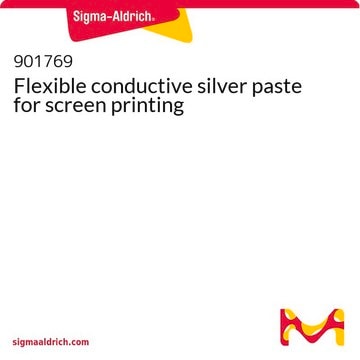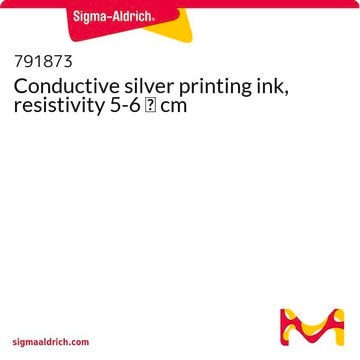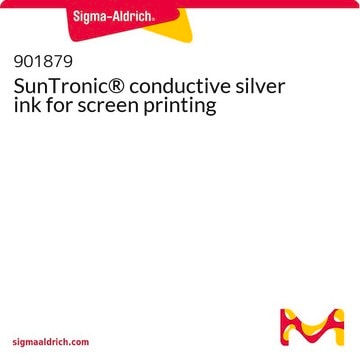This platinum paste has initially been developed as a screen printing paste to obtain a highly conductive and “catalytic” amount of platinum when printed on a transparent substrate (glass, plastics), while allowing the substrates to maintain their transparency after deposition and annealing. The concentration of platinum is therefore quite low (<1%), and the screen printed layer is usually quite thin. Any changes to the product would be for the researcher to experiment with. This paste must be fired at or above 420°C and any modifications made to the product does void the performance guarantee.
791512
Platinum paste, screen printable
Sinonimo/i:
Greatcell Solar PT1 platinum paste, Pt paste, conductive paste
Scegli un formato
Scegli un formato
About This Item
Prodotti consigliati
Stato
paste (Amber)
Livello qualitativo
Viscosità
2500-4500 mPa.s (Analysis carried out at 20°C with 20mm 4 degree cone/plate; 40 s-1)
Temperatura di conservazione
2-8°C
Stringa SMILE
[Pt]
InChI
1S/Pt
BASFCYQUMIYNBI-UHFFFAOYSA-N
Categorie correlate
Applicazioni
PT1 Platinum Paste is oil-based and formulated to be applied using a screen printer; providing films with excellent uniformity; performance and reproducibility; and can be used for DSSC polot production.
After drying; this paste must be fired at or above 420°C. This results in uniformly distributed platinum nanoclusters; providing good transparency and high catalytic activity for the electrochemical reduction of I3- to I-.
Suggested Mesh Screen: 100T
Note legali
Greatcell Solar is a registered trademark of Greatcell Solar Materials Pty Ltd
Avvertenze
Danger
Indicazioni di pericolo
Consigli di prudenza
Classi di pericolo
Eye Dam. 1 - Resp. Sens. 1 - Skin Irrit. 2 - Skin Sens. 1
Codice della classe di stoccaggio
10 - Combustible liquids
Classe di pericolosità dell'acqua (WGK)
WGK 1
Punto d’infiammabilità (°F)
194.0 °F
Punto d’infiammabilità (°C)
90 °C
Scegli una delle versioni più recenti:
Possiedi già questo prodotto?
I documenti relativi ai prodotti acquistati recentemente sono disponibili nell’Archivio dei documenti.
I clienti hanno visto anche
Articoli
Dye-sensitized solar cells (DSCs) are 3rd generation solar cells combining the promise of high efficiency with low production costs.
While dye sensitization as the basis for color photography has been accepted for a very long time,1 attempts to use this principle for the conversion of solar light to electricity generally had resulted only in very low photocurrents, below 100 nA/cm
Professors Tokito and Takeda share design principles and optimization protocols for organic electronic devices, focusing on flexibility and low cost.
Progress in solution-processed functional materials leads to thin-film optoelectronic devices for industrial and consumer electronics.
-
Can the paste be thinned using solvent? If so, which? Also, will be paste become solid if cured underneath the 420degC temperature? And would it adhere to a polymer substrate? Thanks!
1 answer-
Helpful?
-
-
Does it work as a conductive paste? Do you have the resistivity of the paste?
1 answer-
Unfortunately, Product 791512 has not been tested for its properties in terms of conductivity or resistivity. Rather, it was developed for its catalytic properties.
Helpful?
-
Active Filters
Il team dei nostri ricercatori vanta grande esperienza in tutte le aree della ricerca quali Life Science, scienza dei materiali, sintesi chimica, cromatografia, discipline analitiche, ecc..
Contatta l'Assistenza Tecnica.












